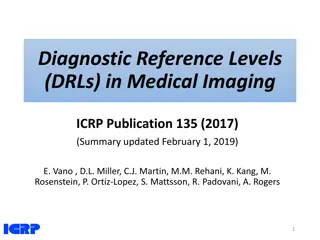Advantages and Challenges of JPEG XL in Whole Slide Imaging (WSI)
JPEG XL offers significantly smaller images for WSI with lossy compression accepted by regulators, supporting >8-bit compression and safe migration from existing JPEG. However, challenges exist such as lack of universal browser support and potential impact on CAD AI. Mayo's limited testing shows promising results with no visual difference and interest in lossless transcoding. Vendors are exploring direct generation of JPEG XL with focus on reducing artifacts and enhancing streaming efficiency for WSI applications.
Download Presentation

Please find below an Image/Link to download the presentation.
The content on the website is provided AS IS for your information and personal use only. It may not be sold, licensed, or shared on other websites without obtaining consent from the author.If you encounter any issues during the download, it is possible that the publisher has removed the file from their server.
You are allowed to download the files provided on this website for personal or commercial use, subject to the condition that they are used lawfully. All files are the property of their respective owners.
The content on the website is provided AS IS for your information and personal use only. It may not be sold, licensed, or shared on other websites without obtaining consent from the author.
E N D
Presentation Transcript
JPEG XL DICOM Supplement 232
Benefits of JPEG XL Significantly smaller images for WSI Lossy compression for WSI has been accepted by regulators using JPEG Safari and Firefox both support JPEG XL Supports lossy >8 bit compression Ability to forward migrate into JPEG XL without any loss of fidelity with existing JPEG, as a safe migration option with full backwards compatibility As DICOMweb response is multiframe at much higher quality than gif As lossless web response, is much smaller than PNG and easier to decode Works well for both natural and synthetic images
Issues with JPEG XL Not yet supported in all browsers, mitigated by WASM javascript modules (still zero footprint) Acknowledge potential effect of any lossy compression on CAD AI or quantitative algorithms. Patent issue that had occurred with Microsoft was determined to not be relevant by the JPEG XL community
Experience with WSI with JPEG XL Limited testing with JPEG XL at Mayo (6 months overall, 3 months concerted) No visual difference from what is seen, with 50-60% smaller Multiple tiles, not all in one file Site has 40 million slides Very interested in the lossless transcoding from JPEG to JPEG XL Testing is not exhaustive yet Both multi-resolution in a single file and separated files Profiling results show that JPEG XL is fast enough for decoding/encoding, but is not as fast as JPEG
Vendor Perspective WSI scanner vendors are interested in trying to generate JPEG XL directly Reduction in artifacts is important for algorithms processing, and is better with JPEG XL Streaming of data to both algorithms and viewers is important and better with JPEG XL Can render portions of a tile that are important first (progressive) WSI has archives several times bigger than radiology Mayo ~ 4 petabytes of data per year May well be able to reduce quality to reduce size further without reducing machine or user quality as JPEG XL has lots of options with very few artifacts Working on multi-spectral and multiple z-depths already, which is not well supported, and adds another order of magnitude in storage size
DICOMweb Usage Need to add JPEG XL transfer syntaxes to DICOMweb JPEG XL provides an alternative to gif for multiframe rendered JPEG XL is a logical extension to baseline JPEG, especially if easily supported in browsers. JPEG XL is useful for color/lossy images as a replacement for JPEG whereas the HTJ2K is not very good for lossy compression, and is very good at lossless compression























